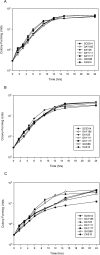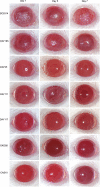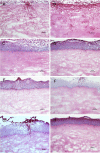The RIM101 signal transduction pathway regulates Candida albicans virulence during experimental keratomycosis
- PMID: 20375342
- PMCID: PMC2941167
- DOI: 10.1167/iovs.09-4726
The RIM101 signal transduction pathway regulates Candida albicans virulence during experimental keratomycosis
Abstract
Purpose: To examine the role of the fungal RIM101 signal transduction pathway in the pathogenesis of Candida albicans keratitis.
Methods: C. albicans wild-type strain SC5314, prototrophic mutant control DAY185, and homozygous fungal mutants for the rim8, rim13, rim20, rim101, and phr1 genes were evaluated in vitro using proliferation and filamentation assays. Scarified corneas of BALB/c and C57BL/6J mice were topically inoculated and observed daily for keratitis severity. Corneal adaptation and pathogenicity were assessed ex vivo by maintaining infected porcine corneas for 3 days in an explantation culture system for histologic evaluation of hyphal penetration.
Results: All C. albicans strains had similar growth kinetics, and SC5314 and DAY185 demonstrated pH-induced filamentation. Fungal mutants had reduced hyphal formation at alkaline and neutral pH, but normal acidic assays ascertained that mutant strains did not have a generalized filamentation defect. SC5314 and DAY185 caused moderate to severe keratitis in mice, whereas fungal strains lacking constituents of the RIM101 pathway had significantly (P<0.05) attenuated severity in vivo. Three days after inoculation of porcine corneas, SC5314 and DAY185 produced hyphae that penetrated 28% and 25%, respectively, of the corneal thickness, and all five mutant strains showed significantly (P<0.05) less stromal penetration.
Conclusions: The RIM101 signal transduction pathway plays an important role in the development of C. albicans keratitis. The fungal pathway intermediates Rim8p, Rim13p, Rim20p, and Rim101p and the downstream cell-wall protein Phr1p are pivotal in the process of corneal invasion by C. albicans.
Figures






Similar articles
-
Candida albicans strain-dependent virulence and Rim13p-mediated filamentation in experimental keratomycosis.Invest Ophthalmol Vis Sci. 2007 Feb;48(2):774-80. doi: 10.1167/iovs.06-0793. Invest Ophthalmol Vis Sci. 2007. PMID: 17251477
-
Genetically regulated filamentation contributes to Candida albicans virulence during corneal infection.Microb Pathog. 2007 Feb-Mar;42(2-3):88-93. doi: 10.1016/j.micpath.2006.11.005. Epub 2007 Jan 22. Microb Pathog. 2007. PMID: 17241762 Free PMC article.
-
Morphogenic and genetic differences between Candida albicans strains are associated with keratomycosis virulence.Mol Vis. 2009 Jul 30;15:1476-84. Mol Vis. 2009. PMID: 19649176 Free PMC article.
-
Cell wall associated proteins involved in filamentation with impact on the virulence of Candida albicans.Microbiol Res. 2022 May;258:126996. doi: 10.1016/j.micres.2022.126996. Epub 2022 Feb 22. Microbiol Res. 2022. PMID: 35247799 Review.
-
Adaptation to environmental pH in Candida albicans and its relation to pathogenesis.Curr Genet. 2003 Oct;44(1):1-7. doi: 10.1007/s00294-003-0415-2. Epub 2003 Jun 18. Curr Genet. 2003. PMID: 12819929 Review.
Cited by
-
Profiling of Candida albicans gene expression during intra-abdominal candidiasis identifies biologic processes involved in pathogenesis.J Infect Dis. 2013 Nov 1;208(9):1529-37. doi: 10.1093/infdis/jit335. Epub 2013 Sep 4. J Infect Dis. 2013. PMID: 24006479 Free PMC article.
-
The Role of Glycoside Hydrolases in S. gordonii and C. albicans Interactions.Appl Environ Microbiol. 2022 May 24;88(10):e0011622. doi: 10.1128/aem.00116-22. Epub 2022 May 4. Appl Environ Microbiol. 2022. PMID: 35506689 Free PMC article.
-
Cryptococcal titan cell formation is regulated by G-protein signaling in response to multiple stimuli.Eukaryot Cell. 2011 Oct;10(10):1306-16. doi: 10.1128/EC.05179-11. Epub 2011 Aug 5. Eukaryot Cell. 2011. PMID: 21821718 Free PMC article.
-
Candida albicans pathogenicity mechanisms.Virulence. 2013 Feb 15;4(2):119-28. doi: 10.4161/viru.22913. Epub 2013 Jan 9. Virulence. 2013. PMID: 23302789 Free PMC article. Review.
-
Candida-streptococcal mucosal biofilms display distinct structural and virulence characteristics depending on growth conditions and hyphal morphotypes.Mol Oral Microbiol. 2015 Aug;30(4):307-22. doi: 10.1111/omi.12095. Epub 2015 Apr 20. Mol Oral Microbiol. 2015. PMID: 25754666 Free PMC article.
References
-
- Ruhnke M. Epidemiology of Candida albicans infections and role of non-Candida albicans yeasts. Curr Drug Targets. 2006;7:495–504 - PubMed
-
- Shah CP, McKey J, Spirn MJ, Maguire J. Ocular candidiasis: a review. Br J Ophthalmol. 2008;92:466–468 - PubMed
-
- Mitchell AP. Dimorphism and virulence in Candida albicans. Curr Opin Microbiol. 1998;1:687–692 - PubMed
Publication types
MeSH terms
Substances
Grants and funding
LinkOut - more resources
Full Text Sources
Medical
Molecular Biology Databases

